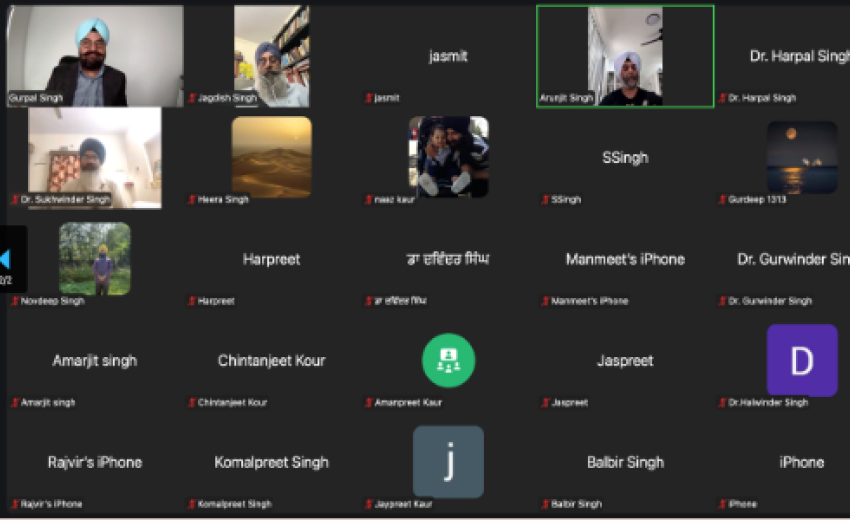Sunday October 12, 2025, an academic conversation on the interpretation of Gurbani took center stage at a special webinar hosted by Naad Pargaas Australia. The program featured a major lecture by Dr. Harpal Singh of the Central University of Kashmir titled “Exegesis of Gurbani and the Commentaries on Japji: Tradition and Future Possibilities,” and a panel of commentators who together mapped the history, diversity and methodological challenges of reading Gurbani especially the foundational composition Japji Sahib.
Arunjit Singh described the session as the third in Naad Pargaas Australia’s public series, which earlier this year examined topics such as Khalsa Sajna and contemporary forms of Shabad Kirtan. The webinar drew scholars and participants from Australia, India and the United States, and the discussion underlined a shared concern: how to renew Sikh exegesis so that it remains faithful to tradition while addressing contemporary philosophical, historical and religious questions.
Dr. Harpal Singh whose doctoral research focuses on the commentaries and interpretations of Japji opened the lecture with a historical sweep and a methodological critique. He emphasized that Japji Sahib occupies an axis position in Sikh thought: declared by tradition to be Dhur Ki Bani as the composition is both the seed of Sikh metaphysics and a practico-spiritual guide for Naam and Sadhana.
Tracing the lineage of interpretation, Dr. Harpal identified three major genealogies for Gurbani commentary: the living oral katha tradition associated with early Gursikhs and the Janam Sakhi corpus; sectarian and philosophical readings from Udasi and Nirmala currents; and the modern, often reformist commentaries that emerged during and after the Singh Sabha movement. He noted that more than 500 commentaries on Japji have been catalogued by academic bibliographies a testimony to the text’s centrality and the interpretive energy it has inspired.
A significant portion of Dr. Harpal’s lecture placed the Sikh interpretive tradition in conversation with Western hermeneutics. He sketched the intellectual trajectory from Schleiermacher’s methodical hermeneutics to Heidegger and Gadamer’s ontological turn, and to Paul Ricœur’s insistence on the ontological and symbolic dimensions of interpretation. For Dr. Harpal, these debates offer conceptual apparatus to think about how Gurbani’s language and symbolic density interact with historical consciousness and the reader’s subjectivity.
Panelists underscored how modern commentaries reflect their historical contexts. Bhai Vir Singh well-known for combining poetic sensitivity, etymology and devotional practice in his Santhia was held up as an exemplar who reconciled linguistic exegesis with Naam-centered sadhana. By contrast, colonial-era translators such as Ernest Trumpp and later Macauliffe were criticized for interpretive frames shaped by missionary and colonial presuppositions, while figures like Puran Singh and Gurbachan Singh were praised for offering mystical and postmodern inflections respectively.
Commentators on the panel argued repeatedly that no single method exhausts Gurbani’s meanings. Dr. Harpal and subsequent respondents mapped a range of interpretive tools such as tika, bhash, vyakhya, santhia, katha each performing distinct functions from lexical clarification to philosophical exposition and spiritual formation. Heera Singh and Gurdeep Singh, both research scholars associated Punjabi University Patiala and Central University of Kashmir respectively, drew attention to the interplay of sadhana (practice) and exegesis: commentary can cleanse inauthentic doubts and make the path to surat (consciousness) and shabad clearer, yet ultimately the text’s living power is realized in practice.
Heera Singh revisited contested commentaries with nuance. The Nirmala and Udasi readings were often criticized historically for Vedantic borrowings; yet he urged sympathetic reappraisal, arguing that these readings enriched Sikh philosophical vocabulary even as they risked essentializing Naam. Osho’s meditative, Sadhana-oriented reading of Japji was recognized for its existential resonance despite limits in assimilating distinct Sikh ontologies.
Dr. Sukhwinder Singh of Panjab University framed the debate as an urgent methodological task: as new philosophical and existential questions surface, Sikh studies must develop ways to account for literal, implied, allegorical and mystical senses of Gurbani. He suggested an expanded research agenda that includes cognitive, phenomenological and neurology-informed studies of how practice and interpretation transform subjectivity. He also suggested to produce rigorous technical dictionaries and terminological glossaries for canonical compositions such as Japji Sahib, Sukhmani Sahib and Sidh Gosht. Dr. Sukhwinder Singh called for sustained philological and philosophical work: “We need dictionaries of 100, 200 or 400 pages for one Bani,” he said, to operationalize the language of Gurbani for contemporary scholarship.
Harpeet Singh from Perth, Western Australia, who was unable to attend the live programme, shared his reflections later, noting that the exposition of Japuji Sahib continues in the Sehaj mode throughout the Guru Granth Sahib. He further emphasized that the meanings of Gurbani are ever-renewing, as its discourse unfolds in the present moment. Thus, its significance blossoms in relation to the context of whoever engages with it. Gurpal Singh (Barrister and Solicitor, Melbourne) moderated the entire session. Simranjit Singh of Naad Pargaas Australia closed the session by thanking speakers.
Click here to watch on YouTube


